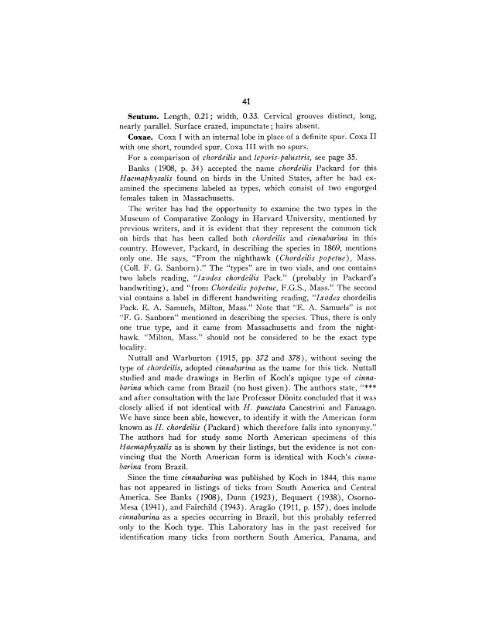The Genera Boophilus Rhipicephalus and Haemaphysalis (Ixodidae ...
The Genera Boophilus Rhipicephalus and Haemaphysalis (Ixodidae ...
The Genera Boophilus Rhipicephalus and Haemaphysalis (Ixodidae ...
You also want an ePaper? Increase the reach of your titles
YUMPU automatically turns print PDFs into web optimized ePapers that Google loves.
Length, 0.21; width, 0.33. Cervical grooves distinct, long,<br />
Seutum.<br />
parallel. Surface crazed, impunctate hairs absent.<br />
nearly<br />
one short, rounded spur. Coxa III with no spurs.<br />
with<br />
a<br />
comparison o.f chordeilis <strong>and</strong> leporis-palustris, see page 35.<br />
For<br />
(1908, p. 34) accepted the name chordeilis Packard for this<br />
Banks<br />
found on birds in the United States, after he had ex-<br />
<strong>Haemaphysalis</strong><br />
the specimens labeled as types, which consist of two engorged<br />
amined<br />
taken in Massachusetts.<br />
females<br />
writer has had the opportunity to examine the two types in the<br />
<strong>The</strong><br />
of Comparative Zoology in Harvard University, mentioned by<br />
Museum<br />
writers, <strong>and</strong> it is evident that they represent the common tick<br />
previous<br />
birds that has been called both chordeilis <strong>and</strong> cinnaba.rina in this<br />
oh<br />
However, Packard, in describing the species in 1869, mentions<br />
country.<br />
one. He .says, "From the nighthawk (Chordeilis popetue), Mass.<br />
only<br />
F. G. Sanborn)." <strong>The</strong> "types" are in two vials, <strong>and</strong> one contains<br />
(Coll.<br />
labels reading, "Ixodes chordeilis Pack." (probably in Packard's<br />
two<br />
<strong>and</strong> "from Chordeilis popetue, F.G.S., Mass." <strong>The</strong> second<br />
h<strong>and</strong>writing),<br />
contains a label in different h<strong>and</strong>writing reading, "Ixodes chordeilis<br />
vial<br />
E. A. Samuels, Milton, Mass." Note that"E. A. Samuels is not<br />
Pack.<br />
G. Sanborn" mentioned in describing the species. Thus, there is only<br />
"F.<br />
true type, <strong>and</strong> it came from Massachusetts <strong>and</strong> from the nighthawk.<br />
one<br />
"Milton, Mass. ' should n,o.t be considered to be the exact type<br />
locality.<br />
<strong>and</strong> Warburton (1915, pp. 372 <strong>and</strong> 378), without seeing the<br />
Nuttall<br />
<strong>and</strong> made drawings in Berlin of Koch's u.nique type of cinnabarina<br />
studied<br />
which came from Brazil (no host given). <strong>The</strong> authors state, "***<br />
after consultation with the late Professor D6nitz concluded that it was<br />
<strong>and</strong><br />
allied if not identical with H. punctata Canestrini <strong>and</strong> Fanzago.<br />
closely<br />
as H. chordeilis (Packard) which therefore falls into synonymy."<br />
known<br />
authors had for study some North American specimens of this<br />
<strong>The</strong><br />
as is shown by their listings, but the evidence is not <strong>Haemaphysalis</strong> convincing<br />
that the North American form is identical with Koch's cinna-<br />
from Brazil.<br />
barina<br />
the time cinnabarina was published by Koch in<br />
Since<br />
1844, this name<br />
not appeared in listings of ticks from South America <strong>and</strong> Central<br />
has<br />
See Banks (1908), Dunn (1923), Bequaert (1938),Osorno-<br />
America.<br />
Mesa (1941), <strong>and</strong> Fairchild (1943). Arago (1911, p.<br />
as a species occurring in Brazil, but this probably referred<br />
cinnabarina<br />
to the Koch type. This Laboratory has in the past received for<br />
only<br />
41<br />
Coxae.<br />
Coxa I with an internal lobe in place of a definite spur. Coxa II<br />
type of chordeilis, adopted.cinnabarina as the name for this tick.<br />
Nuttall<br />
We have since been able, however, to identify it<br />
with the American form<br />
157), does include<br />
identificati,on many ticks from northern South America, Panama, <strong>and</strong>

















